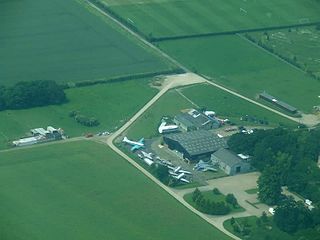
The de Havilland DH.82 Tiger Moth is a 1930s British biplane designed by Geoffrey de Havilland and built by the de Havilland Aircraft Company. It was operated by the Royal Air Force (RAF) and other operators as a primary trainer aircraft. In addition to the type's principal use for ab initio training, the Second World War had RAF Tiger Moths operating in other capacities, including maritime surveillance and defensive anti-invasion preparations; some aircraft were even outfitted to function as armed light bombers.
Sir George Francis Hampson, 10th Baronet was an English entomologist.

The de Havilland Aircraft Museum, formerly the de Havilland Aircraft Heritage Centre, is a volunteer-run aviation museum in London Colney, Hertfordshire, England. The collection is built around the definitive prototype and restoration shops for the de Havilland Mosquito and also includes several examples of the de Havilland Vampire – the third operational jet aircraft in the world. The museum is the largest such museum devoted to one manufacturer in the country.

The de Havilland DH.60 Moth is a 1920s British two-seat touring and training aircraft that was developed into a series of aircraft by the de Havilland Aircraft Company.

Schinia, commonly called flower moths, is a large genus of moths belonging to the family Noctuidae. The genus has a Holarctic distribution with the vast majority of species being found in North America, many with a very restricted range and larval food plant.

Heliodinidae, commonly known as sun moths, is a family of small moths with slender bodies and narrow wings. Members of this family are found in most parts of the world. Heliodinid moths are brightly coloured day-flying moths. The base of the haustellum is bare. The scales on the head are compact and appear like a shield. Many Heliodinidae raise their hindlegs when resting but this is not a taxonomic feature and several genera like Epicroesa and Lamprolophus do not show this posture. Many Heliodinidae have the inner and outer spurs of the metatibia subequal. The larval host plants of the majority of species are in the Aizoaceae, Chenopodiaceae, Phytolaccaceae, Portulacaceae and Nyctaginaceae, all in the Order Caryophyllales. A few feed on Onagraceae, Araliaceae and Piperaceae. The pupae have long stiff hairs on their back sides.
Agathiphaga is a genus of moths, known as kauri moths. It is the only living in the family Agathiphagidae. This caddisfly-like lineage of primitive moths was first reported by Lionel Jack Dumbleton in 1952, as a new genus of Micropterigidae.

The Thyatirinae, or false owlet moths, are a subfamily of the moth family Drepanidae with about 200 species described. Until recently, most classifications treated this group as a separate family called Thyatiridae.
Hysterocladia is a genus of moths in the family Megalopygidae.
Hysterocladia tolimensis is a moth of the family Megalopygidae. It was described by Walter Hopp in 1927. It is found in Colombia.
Hysterocladia conjuncta is a moth of the family Megalopygidae. It was described by Walter Hopp in 1927. It is found in Ecuador.
Hysterocladia elongata is a moth of the family Megalopygidae. It was described by Walter Hopp in 1927. It is found in Peru.
Hysterocladia ferecostata is a moth of the family Megalopygidae. It was described by Walter Hopp in 1927. It is found in Peru.
Hysterocladia latiunca is a moth of the family Megalopygidae. It was described by Walter Hopp in 1927. It is found in Brazil.
Hysterocladia primigenia is a moth of the family Megalopygidae. It was described by Walter Hopp in 1927. It is found in Peru.
Hysterocladia eriphua is a moth of the Megalopygidae family. It was described by Paul Dognin in 1914. It is found in Panama.
Hysterocladia lena is a moth of the Megalopygidae family. It was described by Schaus in 1912. It is found in Costa Rica.
Hysterocladia mirabilis is a moth of the Megalopygidae family. It was described by Schaus in 1905. It is found in Colombia.
Hysterocladia roseicollis is a moth of the Megalopygidae family. It was described by Paul Dognin in 1914. It is found in Peru and French Guiana.
Hysterocladia unimana is a moth of the family Megalopygidae. It was described by Walter Hopp in 1943. It is found in Brazil.





